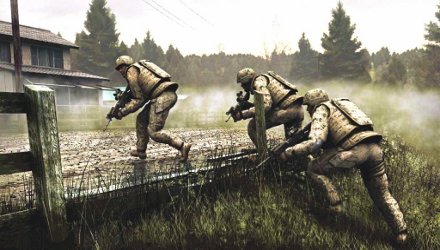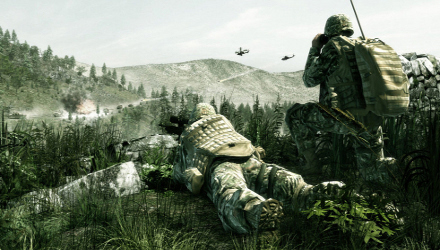Reviews
Review: Operation Flashpoint: Dragon Rising
October 19, 2009, Author: Brian Gourlay
I am a fool. It seems just like yesterday that I thought Call of Duty: Modern Warfare on hardcore mode was as realistic as it could get on a console. I mean you only got a radar half the time for goodness sake! Well, that was before I got my hands on Operation Flashpoint: Dragon Rising, the military simulator from Codemasters. The first Operation Flashpoint achieved unprecedented realism way back in 2001, so I was excited to find out how the new developers were going to take the series forward.
An official sequel has been a long time coming, and I think everyone has been slightly wary of how this ultra realistic series would translate over to consoles. So I strapped on my gear (stop sniggering) and dropped into the landing zone (I said stop it!). My mission? To find out if this war really can be fought on a next gen console, or if the military simulator is doomed to remain on the PC where it has excelled so many times before.
Disclaimer: For the sake of your sanity, you should accept that by putting this game in your disc drive, you are going to die. A lot. Don’t say I didn’t warn you.
Welcome to Skira. You’ll never leave (without dying a few times)
Dragon Rising takes place on the fictional island of Skira, which you’re treated to the history of through a brief but pretty cool cut-scene. Skira has been a source of tension between Russia and China for centuries, with Russia currently occupying the island. More recently however, China has seen much more hard-line politicians take power due to Chinese populace taking a massive hit from a global economic recession. Just to make things a bit juicier, a massive oil reserve has been discovered underneath Skira. Both sides have mobilised their military and in an effort to avoid all out war, Russia has asked America to swoop in and deal with the situation. This is where your group of highly trained US Marines is dropped into the fray, allowing the liberation of Skira Island to being in earnest…
I like the fact that the foundations of the story are so topical. Instead of megalomaniacal dictators wanting to nuke every nursery in the UK, you’re part of a politically driven peacekeeping conflict. Unfortunately, once you’re dropped into Skira, the story just stops dead. Sure, there are developments on the island, Chinese forces taking control of parts of the island, squadrons who get themselves into trouble etc, but after that initial cut-scene you find yourself simply moving from mission to mission without any perspective of the conflict as a whole.
Pretty much all of the dialogue is restricted to your team receiving orders and intel from Command, or you giving orders to the rest of your team. I can only assume that the jargon is correct, but being honest I’m pretty clueless as to what everyone else is saying half the time. That being said, the voice acting is well done and it is pretty cool listening to the sheer volume of military speak that is fired between allies.
“You want easy Private?! Then switch your console off YOU MAGGOT!”
The first thing that struck me about Dragon Rising is that Skira is massive. There is no danger of you being stuck in corridor like zones trying to push forward until the enemy stops spawning, this is as open a warzone as I have experienced in a game. The world that you play in is actually very heavily based on the island of Kiska, so the environment comes across as very natural and real. Sure Codemasters have thrown in a village here, a SAM site there but it really feels like you’ve been dropped into a real island off the coast of Russia. As a result of the sheer size of the place, you’ll often find yourself hiking for long periods towards your next mission, but I never found this boring simply because of the sheer beauty of Skira, and it gives the more hardcore tacticians plenty of space and time to devise a plan and spick the perfect spot to enter a conflict.

Get behind cover! No, the other side!
It’s worth noting that Operation Flashpoint doesn’t have to be soul crushingly hard if you don’t want it to be. Less experienced players can select “mind bogglingly hard”, and intermediate players can go for “just about achievable” difficulty. The different difficulty levels actually don’t change anything like your health, enemies accuracy or how much ammo you can carry, the only things that do change are the in game cues that help you along. Compasses, enemy positions, ammo counters, checkpoints and the like will gradually disappear as the difficulty increases, until you’re at Hardcore difficulty and you get mocked and blown up by The Terminator if you so much as think about pausing the game.
Ok, the last one was bit of an exaggeration, but the level of realism in the game does make Dragon Rising a very unique FPS experience. This is a game that rewards patient, thoughtful build up and quick execution, rather than mindless running and gunning. You’ll often find at the very least a few hundred metres between you and your next objective, which means it can be all the more frustrating when you get popped in the head without even knowing you’re in a gunfight. On the other hand, it’s an amazing feeling when you’ve just spent time planning your approach, getting into the right position, waiting until the enemy is in range and then taking them down before they’ve even heard the gunshots.
As you’d expect however, that isn’t as easy as it sounds. The weapons in Dragon Rising take a fair bit of getting used to, simply because they act in a more realistic way than in any other console shooter. You have to take every bullet’s trajectory into account, which is particularly difficulty considering the enemy is often a couple of hundred metres away. Even if you get your scope right on an enemy’s bonce, your shot could fall flat when you pull the trigger. Again, this level of difficulty just makes it all the more satisfying when you bag a kill, as you’re treated to a puff of red mist in the distance as your target falls to the ground.
Dragon Rising is a game that, rather than encouraging teamwork, brutally punishes you for trying to go solo. You’ll often find yourself relying on your team to spot enemies and lay down suppressing fire while you get into position, and while they follow orders pretty well, there are some big holes in the squad’s AI. They don’t seem able to fully comprehend getting behind cover and will often stand in the open, unloading a whole clip of ammo at enemy’s ala Jesse Ventura in Predator. Asking them to drive a vehicle is also a no go, as they often simply plot a straight line on the map and follow it unwaveringly, no matter how many obstacles, enemies or massive holes get in the way. This is slightly offset by the fact that the wheel system that you use to give orders to your squad is extremely detailed, if a little bit clunky at times (you can’t give orders while moving it would seem).
Ah, the sight of napalm in the morning
The general template that most of the visuals follow is one of simplicity. The graphics are mostly quite understated, there are no jazzy special effects outside of the menu screens really, but that isn’t to say that they aren’t very, very effective. The draw distance is pretty spectacular, easily on par with the likes of Oblivion and Fallout 3, and there’s no sign of any pop up with some of the more detailed scenery on Skira. A particular highlight of mine was lying in some tall grass on top of a hill, trying to snipe an advancing patrol, only to see an enemy gunship swoop over the horizon, which I took as my cue to leg it. It’s extremely satisfying having such a panoramic view of the battlefield, as you can often devise plans of attack (or retreat if need be) simply be using your eyes, ears and wits.

This might not be the time, but I can totally see my neighbour's rack from here
I found that the explosions in Dragon Rising could have packed a bit more of a punch, but the massive plumes of smoke that arise from burning vehicles are very impressive to look at. Not only that, they give a good indication of where not to go if you’re playing on hardcore. There’s also a full day/night cycle on Skira, which results in some pretty purdy sunrises and sunsets, if you have the time to wait around that is.
Read on for the mental image of the week
There isn’t a lot that can be said about Dragon Rising’s soundtrack since it’s entirely nonexistent apart from the frankly bizarre menu track. It’s hard to explain, so I’ve decided to try and classify it under the moniker “Bulgarian Throat Warbling”. To be honest it just sounds like an overweight frog being tickled by Mickey Mouse. There’s no backing track while you play the game either, which is what I’d expect, and most of the time the only comforting sound you’ll hear while trekking across Skira is the pitter-patter of your squad’s feet.
This brings me nicely to the in-game sound effects, all of which are pretty damn excellent. The sound of bullets whizzing by your head and thudding into nearby scenery is exhilarating, while the sonic boom of gunship fire is terrifying. Don’t expect a grand death requiem if an enemy round finds its way to your skull either, all you get to hear is a sickening wet thump before the screen goes black. It’s probably one of the single most effective sound effects I’ve heard in a game, and it really made me sit back for a second and think, “Woah… I’m dead”.
Band of strangers from across the globe
There are two competitive online modes in Dragon Rising, Annihilation and Infiltration. The first being a straight up deathmatch and the second being an attack and defend shindig. The way that the multiplayer is set up reminds me of my days playing Halo on the PC, in that you have to select a room to join before you actually enter a game lobby. It seems very old fashioned and there are some problems with finding the games that you want, but other than that the whole system is functional enough.
The games themselves though are great fun. Each game type is 4 v 4 with some bots on either side, and the maps are extremely large, which means plenty of scope for vehicle on vehicle warfare, sniper battles and displays of tactical genius. I also like the fact that each team member gets to choose to be a particular member of the squad, such as anti-tank gunner or medic, which makes it much more important for the team to stick together to survive.
You also have the option to play the campaign in co-op with three mates, which is undoubtedly the feather in Dragon Rising’s hat. Simply not having to worry about giving your team simple orders (“Get into cover”, “Stop running off of cliffs”, those kind of things) makes the whole experience much more fun. I also found myself getting much more into the tactical side of things when playing with friends, and by the end we were pulling off flanking manoeuvres like we were the A-Team.
Buy it, try it or avoid it?
It’s hard for me to stay objective when making a final recommendation for Dragon Rising, because I absolutely love it. Its open nature, massive game world and challenging enemies make it a unique experience, and I particularly can’t wait to get stuck into a bit of hardcore co-op. However, I know that any shooter as unforgiving in its realism as Operation Flashpoint will alienate a lot of average FPS fans. I would recommend that anyone who likes a shooter at least give this a try, but it’s important that you approach it in the right manner and give it the respect it deserves. As long as you don’t fall into the “I’m not good at this game therefore the game is bad” category, you’ll be glad you did.
Platforms: PC, PS3, Xbox 360 | Tagged Difficult, Dragon Rising, Open Ended, Operation Flashpint, Simulator



